diff options
| author | Daniel Baumann <daniel.baumann@progress-linux.org> | 2019-09-13 05:05:25 +0000 |
|---|---|---|
| committer | Daniel Baumann <daniel.baumann@progress-linux.org> | 2019-09-13 05:05:25 +0000 |
| commit | d72015c7962af72903326a01fb114f8f2d37eebc (patch) | |
| tree | 5bb5ae6928f3f2a92f478f69c2f5c9aa9333fbf8 /web/README.md | |
| parent | Releasing debian version 1.17.0-3. (diff) | |
| download | netdata-d72015c7962af72903326a01fb114f8f2d37eebc.tar.xz netdata-d72015c7962af72903326a01fb114f8f2d37eebc.zip | |
Merging upstream version 1.17.1.
Signed-off-by: Daniel Baumann <daniel.baumann@progress-linux.org>
Diffstat (limited to 'web/README.md')
| -rw-r--r-- | web/README.md | 228 |
1 files changed, 214 insertions, 14 deletions
diff --git a/web/README.md b/web/README.md index fc230f51d..2636323af 100644 --- a/web/README.md +++ b/web/README.md @@ -1,28 +1,228 @@ # Web dashboards overview -The default port is 19999; for example, to access the dashboard on localhost, use: <http://localhost:19999> +Because Netdata is a health monitoring and _performance troubleshooting_ system, +we put a lot of emphasis on real-time, meaningful, and context-aware charts. -To view Netdata collected data you access its **[REST API v1](api/)**. +We bundle Netdata with a dashboard and hundreds of charts, designed by both our +team and the community, but you can also customize them yourself. -For our convenience, Netdata provides 2 more layers: +There are two primary ways to view Netdata's dashboards: -1. The `dashboard.js` javascript library that allows us to design custom dashboards using plain HTML. For information on creating custom dashboards, see **[Custom Dashboards](gui/custom/)** and **[Atlassian Confluence Dashboards](gui/confluence/)** +1. The [standard web dashboard](gui/) that comes pre-configured with every + Netdata installation. You can see it at `http://SERVER-IP:19999`, or + `http://localhost:19999` on `localhost`. You can customize the contents and + colors of the standard dashboard [using + JavaScript](gui/#customizing-the-standard-dashboard). -2. Ready to be used web dashboards that render all the charts a Netdata server maintains. +2. The [`dashboard.js` JavaScript library](#dashboardjs), which helps you + [customize the standard dashboards](gui/#customizing-the-standard-dashboard) + using JavaScript, or create entirely new [custom dashboards](gui/custom/) or + [Atlassian Confluence dashboards](gui/confluence/). -## Customizing the standard dashboards +You can also view all the data Netdata collects through the [REST API v1](api/). -Charts information is stored at /usr/share/netdata/web/[dashboard_info.js](gui/dashboard_info.js). This file includes information that is rendered on the dashboard, controls chart colors, section and subsection heading, titles, etc. +No matter where you use Netdata's charts, you'll want to know how to +[use](#using-charts) them. You'll also want to understand how Netdata defines +[charts](#charts), [dimensions](#dimensions), [families](#families), and +[contexts](#contexts). -If you change that file, your changes will be overwritten when Netdata is updated. You can preserve your settings by creating a new such file (there is /usr/share/netdata/web/[dashboard_info_custom_example.js](gui/dashboard_info_custom_example.js) you can use to start with). +## Using charts -You have to copy the example file under a new name, so that it will not be overwritten with Netdata updates. +Netdata's charts are far from static. They are interactive, real-time, and work +with your mouse, touchpad, or touchscreen! -To configure your info file set in `netdata.conf`: +Hover over any chart to temporarily pause it and see the exact values presented +as different [dimensions](#dimensions). Click or tap stop the chart from automatically updating with new metrics, thereby locking it to a single timeframe. +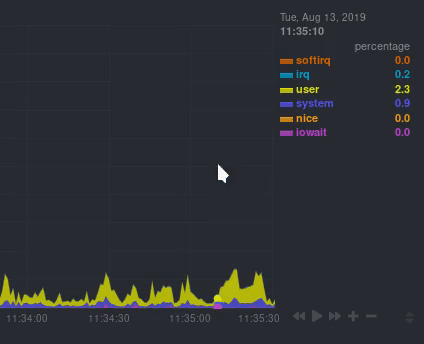 + +You can change how charts show their metrics by zooming in or out, moving +forward or backward in time, or selecting a specific timeframe for more in-depth +analysis. + +Whenever you use a chart in this way, Netdata synchronizes all the other charts +to match it. Chart synchronization even works between separate Netdata agents if you connect +them using the [node menu](../registry)! + +You can change how charts show their metrics in a few different ways, each of +which have a few methods: + +| Manipulation | Method #1 | Method #2 | Method #3 | +|--- |--- |--- |--- | +| **Reset** charts to default auto-refreshing state | `double click` | `double tap` (touchpad/touchscreen) | | +| **Select** a certain timeframe | `ALT` + `mouse selection` | `⌘` + `mouse selection` (macOS) | | +| **Pan** forward or back in time | `click and drag` | `touch and drag` (touchpad/touchscreen) | | +| **Zoom** to a specific timeframe | `SHIFT` + `mouse selection` | | | +| **Zoom** in/out | `SHIFT`/`ALT` + `mouse scrollwheel` | `SHIFT`/`ALT` + `two-finger pinch` (touchpad/touchscreen) | `SHIFT`/`ALT` + `two-finger scroll` (touchpad/touchscreen) | + +Here's how chart synchronization looks while zooming and panning: + +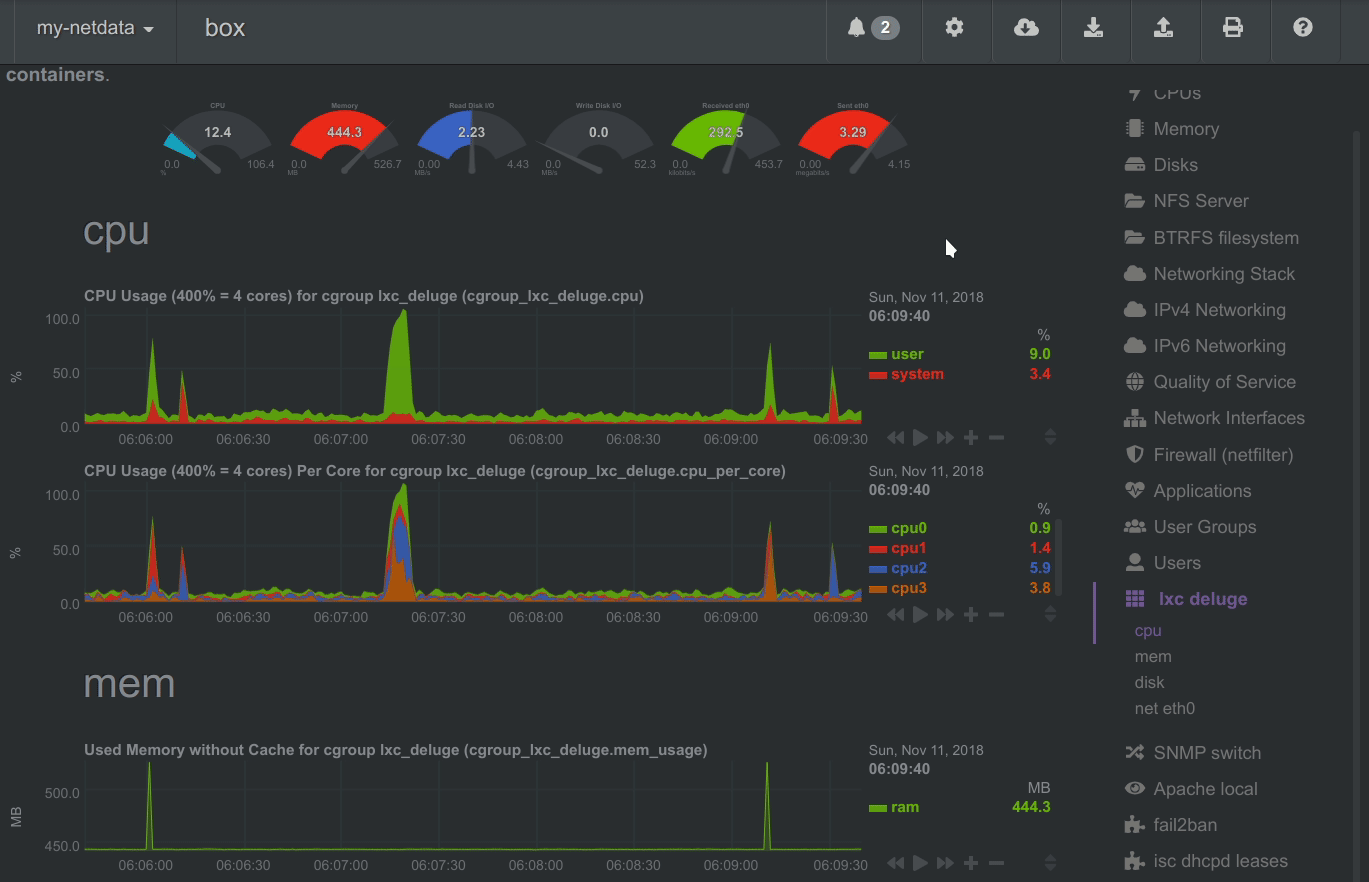 + +You can also perform all these actions using the small +rewind/play/fast-forward/zoom-in/zoom-out buttons that appear in the +bottom-right corner of each chart. + +## Charts, contexts, families + +Before customizing the standard web dashboard, creating a custom dashboard, +configuring an alarm, or writing a collector, it's crucial to understand how +Netdata organizes metrics into charts, dimensions, families, and contexts. + +### Charts + +A **chart** is an individual, interactive, always-updating graphic displaying +one or more collected/calculated metrics. Charts are generated by +[collectors](../collectors/). + +Here's the system CPU chart, the first chart displayed on the standard +dashboard: + + + +Netdata displays a chart's name in parentheses above the chart. For example, if +you navigate to the system CPU chart, you'll see the label: **Total CPU +utilization (system.cpu)**. In this case, the chart's name is `system.cpu`. +Netdata derives the name from the chart's [context](#contexts). + +### Dimensions + +A **dimension** is a value that gets shown on a chart. The value can be raw data +or calculated values, such as percentages, aggregates, and more. + +Charts are capable of showing more than one dimension. Netdata shows these +dimensions on the right side of the chart, beneath the date and time. Again, the +`system.cpu` chart will serve as a good example. + +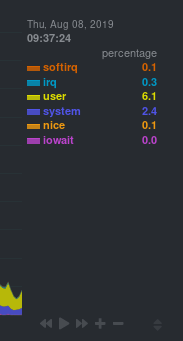 + +Here, the `system.cpu` chart is showing many dimensions, such as `user`, +`system`, `softirq`, `irq`, and more. + +Note that other applications sometimes use the word _series_ instead of +_dimension_. + +### Families + +A **family** is _one_ instance of a monitored hardware or software resource that +needs to be monitored and displayed separately from similar instances. + +For example, if your system has multiple disk drives at `sda` and `sdb`, Netdata +will put each interface into their own family. Same goes for software resources, +like multiple MySQL instances. We call these instances "families" because the +charts associated with a single disk instance, for example, are often related to +each other. Relatives, family... get it? + +When relevant, Netdata prefers to organize charts by family. When you visit the +**Disks** section, you will see your disk drives organized into families, and +each family will have one or more charts: `disk`, `disk_ops`, `disk_backlog`, +`disk_util`, `disk_await`, `disk_avgsz`, `disk_svctm`, `disk_mops`, and +`disk_iotime`. + +In the screenshot below, the disk family `sdb` shows a few gauges, followed by a +few of the associated charts: + +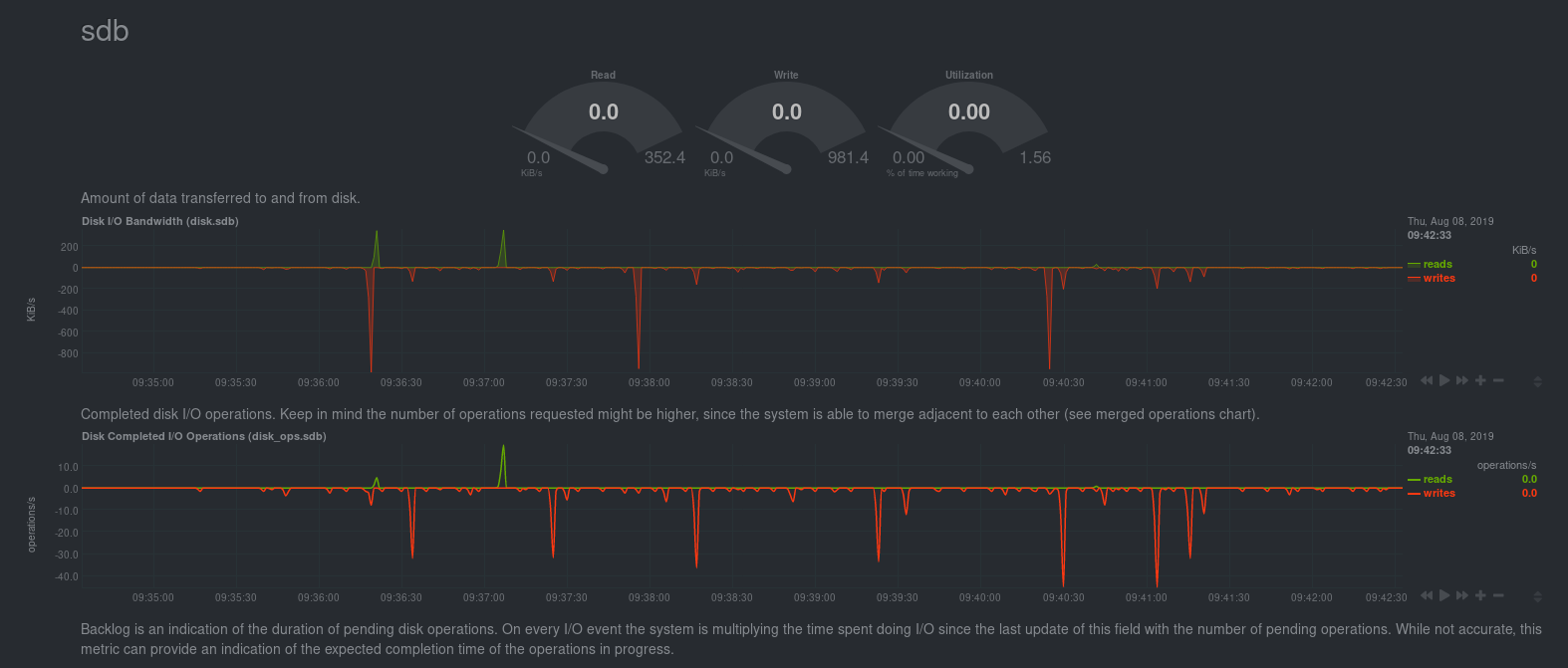 + +Netdata also creates separate submenu entries for each family in the right +navigation page so you can easily navigate to the instance you're interested in. +Here, Netdata has made several submenus under the **Disk** menu. + +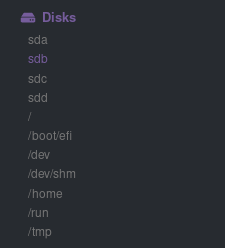 + +### Contexts + +A **context** is a way of grouping charts by the types of metrics collected and +dimensions displayed. Different charts with the same context will show the same +dimensions, but for different instances (families) of hardware/software +resources. + +For example, the **Disks** section will often use many contexts (`disk.io`, +`disk.ops`, `disk.backlog`, `disk.util`, and so on). Netdata then creates an +individual chart for each context, and groups them by family. + +Netdata names charts according to their context according to the following +structure: `[context].[family]`. A chart with the `disk.util` context, in the +`sdb` family, gets the name `disk_util.sdb`. Netdata shows that name in the +top-left corner of a chart. + +Given the four example contexts, and two families of `sdb` and `sdd`, Netdata +will create the following charts and their names: + +Context | `sdb` family | `sdd` family +--- | --- | --- +`disk.io` | `disk_io.sdb` | `disk_io.sdd` +`disk.ops` | `disk_ops.sdb` | `disk_ops.sdd` +`disk.backlog` | `disk_backlog.sdb` | `disk_backlog.sdd` +`disk.util` | `disk_util.sdb` | `disk_util.sdd` + +And here's what two of those charts in the `disk.io` context look like under +`sdb` and `sdd` families: + + + + +As you can see in the screenshot, you can view the context of a chart if you +hover over the date above the list of dimensions. A tooltip will appear that +shows you two pieces of information: the collector that produces the chart, and +the chart's context. + +Netdata also uses [contexts for alarm +templates](../health/#alarm-line-on). You can create an +alarm for the `net.packets` context to receive alerts for any chart with that +context, no matter which family it's attached to. + +## Positive and negative values on charts + +To improve clarity on charts, Netdata dashboards present **positive** values for +metrics representing `read`, `input`, `inbound`, `received` and **negative** +values for metrics representing `write`, `output`, `outbound`, `sent`. + +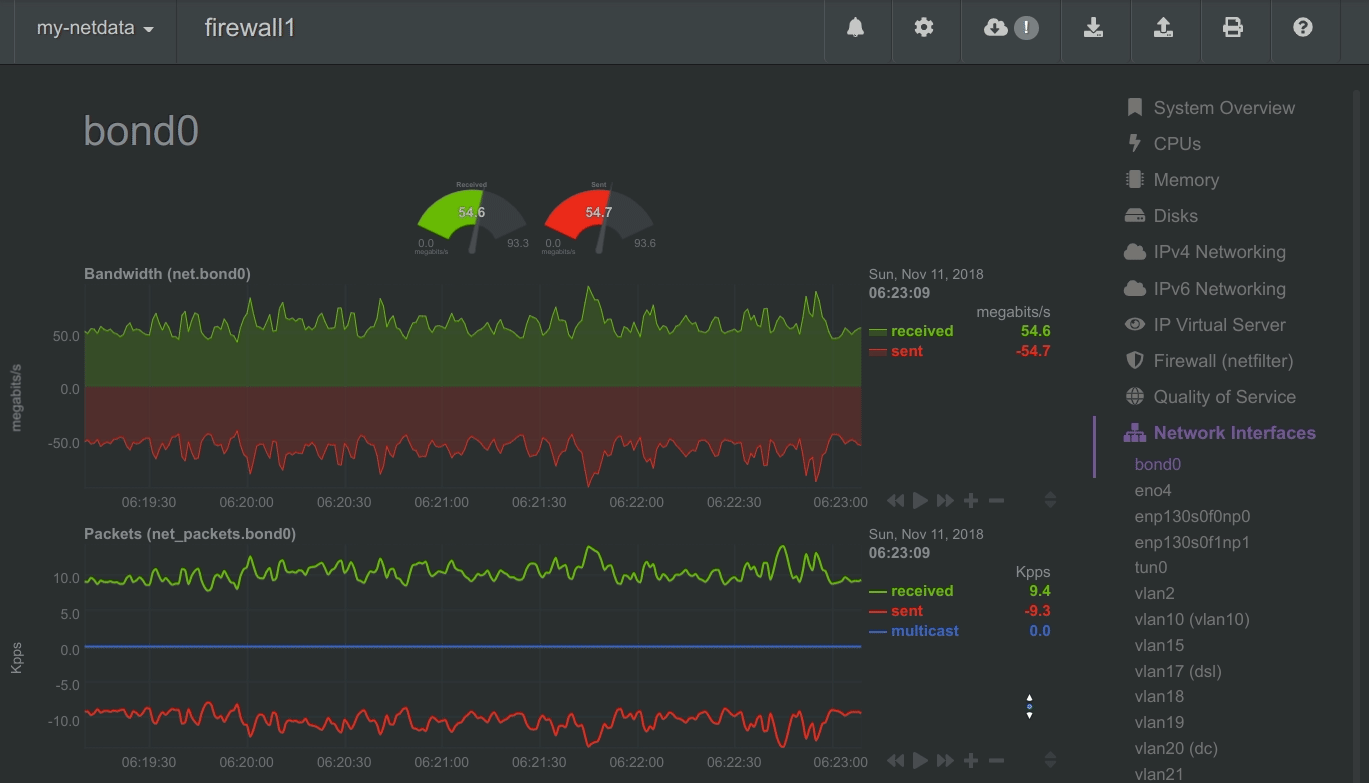 + +_Netdata charts showing the bandwidth and packets of a network interface. +`received` is positive and `sent` is negative._ + +## Autoscaled y-axis + +Netdata charts automatically zoom vertically, to visualize the variation of each +metric within the visible timeframe. + +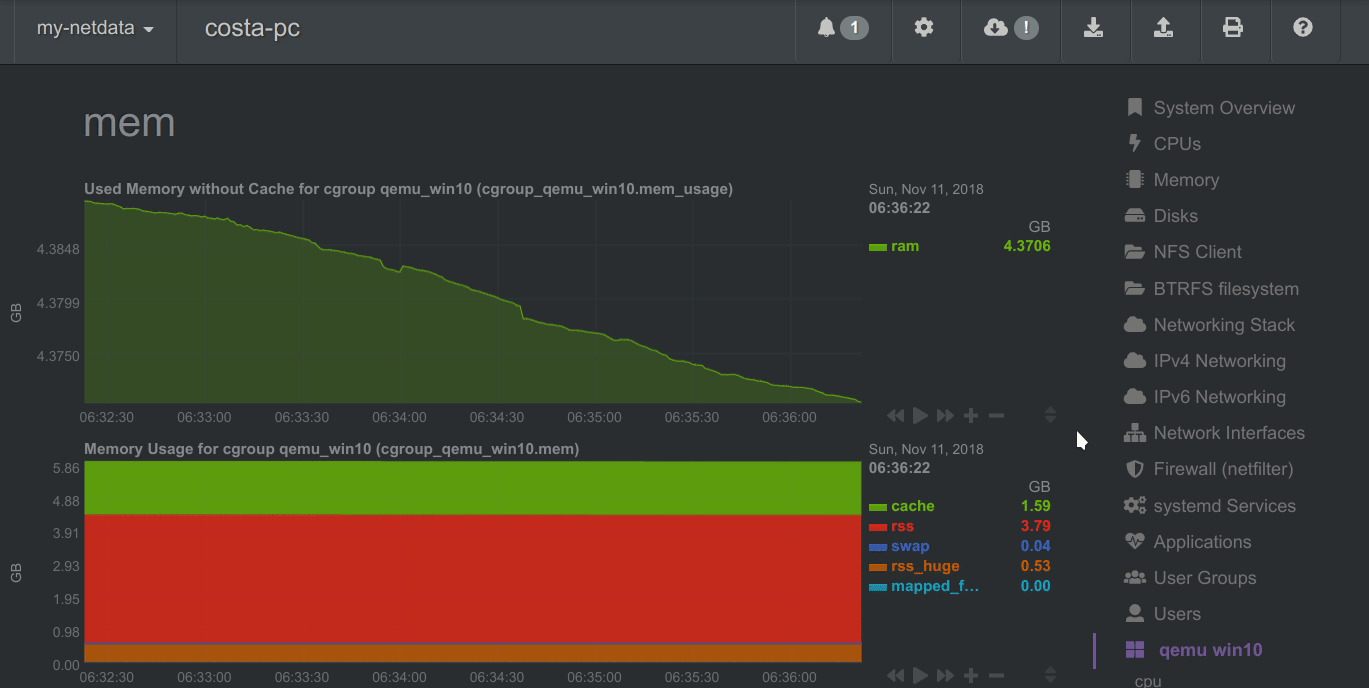 + +_A zero-based `stacked` chart, automatically switches to an auto-scaled `area` +chart when a single dimension is selected._ + +## dashboard.js + +Netdata uses the `dashboards.js` file to define, configure, create, and update +all the charts and other visualizations that appear on any Netdata dashboard. +You need to put `dashboard.js` on any HTML page that's going to render Netdata +charts. + +The [custom dashboards documentation](gui/custom/) contains examples of such +custom HTML pages. + +### Generating dashboard.js + +We build the `dashboards.js` file by concatenating all the source files located +in the `web/gui/src/dashboard.js/` directory. That's done using the provided +build script: + +```sh +cd web/gui +make ``` -[web] - custom dashboard_info.js = your_file_name.js -``` -[](<>) +If you make any changes to the `src` directory when developing Netdata, you +should regenerate the `dashboard.js` file before you commit to the Netdata +repository. + +[]() |
